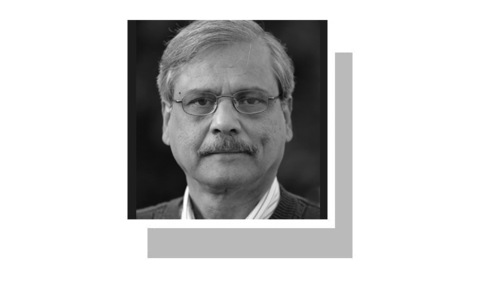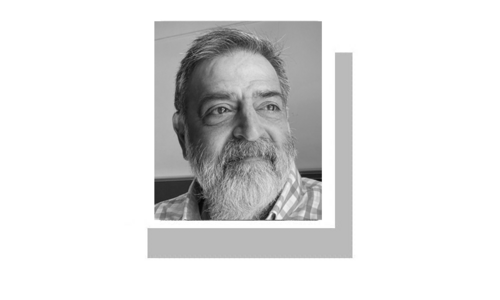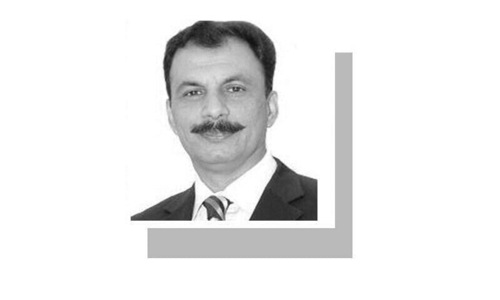
Sunday, June 12, 1976 had been another hot day. With the weekend over, Lahoris gathered at their homes for dinner. The short twilight that marks Lahore’s summers was deepening when, at 7:30pm, residents of Shadman II town, whose homes were close to the Punjab Arts Council (PAC), heard a deafening blast. As fire trucks wailed, news got around: the gallery of the PAC had been bombed. The seething protests against the inimitable artist Sadequain had taken a dangerous turn.
After a successful exhibition at the Khana-i-Aftab in Tehran, where he had the pleasure of turning down Queen Farah Pahlavi’s request for a portrait, Sadequain had arrived in Lahore in February 1976. He lodged in a small cabin on top of the hillock in Bagh-i-Jinnah. Christening it Koh-i-Alwaan, he filled the cabin with canvas after canvas in a frenzy of creativity. Forty figurative works and 40 illustrations of Sadequain’s rubaaiyaat (quatrains) were being displayed in the PAC gallery.
The exhibition opened on May 18 and caused an immediate sensation. There was an instant backlash from religious extremists, who took one look at the paintings and declared them “fuhash” (obscene). The clergy led widespread protests. Right-wing political parties saw another opportunity to gain political mileage. Creative expression was under siege in Pakistan and Sadequain was at the heart of it.
This was not the first attack against creative arts in Pakistan. Manto was brought to trial on obscenity charges. His short stories were banned thrice before Partition and then thrice more in Pakistan after independence. The situation in 1976 was much worse. For decades, Pakistan had been drifting to the right and, after the fall of Dhaka, had laid even more emphasis on its religious ideology. The 1973 Constitution firmly labelled the country as “Islamic”. After the loss of Pakistan’s eastern half, Prime Minister Zulfikar Ali Bhutto looked towards the Middle East and determined that Pakistan should have a paramount place in the comity of Muslim countries. He hosted the Organisation of Islamic Cooperation (OIC) conference in 1974, the same year the National Assemly declared Ahmadis non-Muslims. The onslaught of religious populism was a juggernaut and religious parties were gaining power on the streets and university campuses. Sadequain’s exhibition was another excuse for extremists to gain political ground.
Sadequain had used human anatomy to explore his themes before. His previous exhibitions showed nudes, both grotesque and lissome. Recent exhibitions had nudes of all types, including copulating couples. But there is a difference between nude and naked. He had a message then, as he did in 1976. The figures he painted in Lahore were aloof, shorn of human warmth and emotion. Every man an island, every woman a distant shore. Cobwebs and reptiles stripped away their physical beauty, the materialistic world siphoned their warmth and drove a wedge between genders.
June 30 is Sadequain’s 90th birth anniversary. In tribute to his art and his refusal to submit to censorship, this is an account from 1976 when his exhibition of paintings sparked Pakistan’s first protests against art and divided the country
These were shallow figures, representing the monotony, boredom and disenchantment of empty physical relations. The country spoke of religion even though moral standards were stagnating as a whole. The paintings were a commentary on the double standards of society, that only an artist like Sadequain could express without inhibition, and with refreshing honesty. In fact, if he had any inhibitions about showing the human form, it would have made his art smutty.
By showing society’s reality in graphic detail, Sadequain the Fakir was now Sadequain the Reformer. The paintings were without mercy, their cutting truths difficult to bear, the exposed cancer impossible to ignore. Crass commercialism had overtaken human values, everything was for sale, including humans and affection between genders. Sadequain refused to be unaffected by society and the exhibition was a visceral reaction, every painting a moralism, a sermon, a silent exposé. Images of gnarled, tormented figures in monochromatic tones were juxtaposed with etched, thorny characters rising from the febrile imagination of the artist.
There were six paintings of curvy forms that were reminiscent of Henry Moore’s statues, stolid and occupying the canvas in expansive ways. There were paintings that projected Man and Woman as only one existence and others from the Atlas series which showed them as hemispheres of a planet. The mélange of black and white tones was a denouncement of racial discrimination. The fasting Sadequain under an apple tree was the fakir inspired by Buddha, a self-portrait done ruthlessly with all its faults. The exhibition was a war against hypocrisy. The paintings were bold but pornographic only to a perverse mind.

The visitors at the PAC were nonplussed. One of them said that the only obscene thing he saw was the sight of Sadequain’s bony body in the self-portrait. Much of the furore was over the ‘Bosa’ [Kiss] series and the embraces, described so titillatingly in the Urdu press were that of the condemned but defiant man kissing the gallows as he offers the Azmat-i-Bosa, the Highest Kiss. The right-wing press willfully corrupted the word “bosa”, the esoteric messages and spiritual undertones Sadequain portrayed through calligraphic lines, seemingly beyond their comprehension. They protested vociferously, but it was unclear whether it was the word they hated or the act, as the latter was only suggested and never unveiled.
Soon Lahore was gripped with protests. It was the founding place of the Islami Jamiat-i-Talaba (IJT) and, on May 22, the zealots took to the streets, in the first protest against art in Pakistan. The IJT’s followers from across universities and colleges in Lahore picketed outside the PAC, holding placards that screamed “Kill Sadequain”, “To Hell with Sadequain” and “Death to Sadequain”. Fatwas against Sadequain were passed.
By showing society’s reality in graphic detail, Sadequain the Fakir was now Sadequain the Reformer. The paintings were without mercy, their cutting truths difficult to bear, the exposed cancer impossible to ignore. Crass commercialism had overtaken human values, everything was for sale, including humans and affection between genders. Sadequain refused to be unaffected by society and the exhibition was a visceral reaction, every painting a moralism, a sermon, a silent expose.
The protests spread to Rawalpindi and Islamabad, as the hardliners tried to build pressure on the government. The matter reached the Punjab Assembly, where it was hotly debated on June 4, 1976. Some legislators wanted to pursue the obscenity charge and punish the artist. The man who had painted treasures for state institutions, such as the Mangla Dam, the State Bank of Pakistan and the Lahore Museum, was facing calls to be tarred and feathered.
But the PPP leadership admired Sadequain. In 1959, then Commerce Minister Zulfikar Ali Bhutto had visited Sadequain at his home, Sibtain Manzil. Dr Mubashir Hasan, the Secretary General of PPP, defended him stoutly, and so did Punjab Information Minister Aitzaz Ahsan, who also held the art and culture portfolio. They may have accommodated the extremists on some issues but, on Sadequain, they didn’t budge, although they condemned obscenity overall and a statement was released to that effect.
The intellectual elite of the country rallied in support. On May 28, 32 leading litterateurs released a statement condemning the slander campaign against Sadequain and expressed disappointment over the censorship of the arts. They condemned the campaign as an “attempt to deprive us of our cultural heritage and the best in our literary and artistic values,” reported Pakistan Times on May 27, 1976. The statement’s signatories included Faiz Ahmed Faiz, Intezar Hussain, Kishwar Naheed and Amjad Islam Amjad. In his Urdu column, Ahmed Nadeem Qasmi wrote, “Islam se banday ka musharraf hona Islam ke mufti ko gawara na hua. Un logon ke liye Sadequain ki yeh numaaish bohat baleegh hai jin ke shaoor aur zauq ki tehzeeb kho chuki hai [The cleric of Islam could not bear to see a man entering the fold of Islam. This Sadequain exhibition is completely incomprehensible to those who have no cognition and appreciation of culture].” Qasmi had actually used Sadequain’s rubaai from the exhibition to emphasise his point:
Yeh to nahin qudrat ka ishara na hua
Main phir chala souay kufr, yara na hua
Islam se banday ka musharraf hona
Islam ke mufti ko gawara na hua
[It was not that nature did not provide signs, But once again I am a heretic, there was no attachment A man entering the fold of Islam Was unbearable for the cleric of Islam.]
The Pakistan Artists Equity and Punjabi Adabi Sangat Pakistan also expressed firm support for Sadequain. Their press release stated that the so-called campaign against obscenity was only an attempt to infuse life into the nearly dead Jamaat-i-Islami. Newspaper cartoons mocked the extremists for their perverseness.

Meanwhile, the rightist Urdu press was baying for blood. They called Sadequain a fake, a mimicker and worse, and his art was condemned as an attack against the moral fibre and ideology of Pakistan. One headline bellowed “Sadequain insaan bano! [Sadequain fix yourself!]” while another screamed “Sadequain ki rawayat se baghawat! [Sadquain’s revolt against traditions!]” Nawa-e-Waqt led the way, proclaiming, on May 28, “Sadequain kya se kya ho gaye. Uriani aur zehni kaj-rawi ko art ka naam de kar fikri inteshaar phelanay ki mazmoom koshish [What has Sadequain become? By calling vulgarity and mental aberrations art, he is trying his best to stoke intellectual disruption].” It called for closure of the exhibition and gave prominent coverage to a press conference held by IJT on May 28, which demanded that the exhibition be banned and cases lodged against Sadequain and the exhibition organisers.
Sadequain was indifferent to the fracas. He would be at the exhibition, talking bemusedly to friends who came to console him. He mixed with the crowd that came to rub shoulders with him. He was in his element, the “wheat-complexioned beauties” he called his muses around him asking for autographs and art students vying to catch his attention. “Why should I react to such unintelligent attacks?” he said dismissively. “If I react, I will react strongly and why should I waste an atom bomb on killing a small pest?” (View Point, May 28).
The Fakir was unconcerned about the mufti. Once when M.F. Hussain came to see him, he drew two Urdu letters ‘Noon’, semi circles with dots in the middle and then chuckled, “Whenever the so-called mullahs see this, they proclaim the nudity of feminine form immoral.” But from the two semi circles he created a calligraphy with words Ain-ul-Yaqeen [firm belief], showing that letters are just that: letters. For amusement, he composed rubaiyaat mocking hypocrites, calling the poetry sessions “evenings with the enemies”. For every slur hurled at him by extremists, Sadequain composed another quatrain. He was in excellent spirits, bubbling over with excitement and the very embodiment of Ghalib’s verse:
Baazeechaa-i-atfaal hai duniya miray aagay
Hota hai shab-o-roz tamaasha miray aagay
[The world is a children’s playground before me Night and day, I see a play enacted before me]
In a press conference on May 29, Sadequain made it clear that the paintings were only a representation of society, that only lewd minds would see them as anything else. “Jo loag meri tasveeron ko fuhash aur urian qaraar daitay hain, un ke apnay zehan itnay ganday hain ke dekhnay walay ko karahat mehsoos hoti hai [Those who label my paintings pornographic and vulgar are so dirty-minded that they inspire only loathing],” he said.
The furore led to massive interest in the exhibition. One art critic even jokingly wrote that Sadequain had created the whole controversy on purpose, to make himself even more popular. Thousands streamed in daily to view the paintings, choking the gallery. From the press coverage, it seems they had assumed that the fakir was essentially a local Hugh Hefner. Once inside, however, they were crestfallen. The exhibition was a great letdown for people who had come from afar expecting to see x-rated art.
Perhaps the most apt statement was given by Faiz who, after going through the works, remarked, “If this is pornography, it is most disappointing.” A journalist reported that in a country that produced vulgar posters for Punjabi and Pashto films, “One went into the Punjab Arts Council’s basement in a frenzy of expectations and excitement. The Urdu press had led one to expect embracing, amorous couples a la Khanzada or Khatarnaak.”
By popular demand, on June 1 the PAC extended the display for 12 more days. Seeing their protests failing, the hardliners resorted now to drastic measures. While Sadequain was in Islamabad, his exhibition was bombed. Several paintings were destroyed as a fire broke out in the gallery. A broken window near the verandah showed where the bombs had been thrown and police investigations revealed sulphur marks where they had exploded.
The bombing finally quelled the turmoil that had gripped the country for the past weeks. It was roundly condemned. “Sadequain ke fun par sirf Jamaat pasand ko aiteraz hai [Only the followers of Jamaat object to Sadequain’s paintings],” PPP founding member S.M. Masood declared. Sadequain was phlegmatic, he had proven his point. The fakir had triumphed and would spend another 11 years unbowed and unbent.
Sadequain’s 90th birthday is an occasion to reflect on where Pakistan stands in the battle between the creative forces and their oppressors. The legacy of those who called for Sadequain’s head has thrived. In 1990, artist Colin David’s house was vandalised by gun-wielding extremists who attacked him for his “vulgar” art. Recently, just over the past 12 months, an art exhibit at the Karachi Biennale 2019 has been damaged, copies of the Urdu translation of an English novel have been seized and a movie has been stopped from release. Social media and press are monitored and gagged.
Maybe it’s a good thing Sadequain is not physically here now. Unrepentant as he was, he may have had to share the sufi
Sarmad’s fate. Knowing him, he would have marched to the gallows with a smile, reciting his rubaai and his lips ready for the Azmat-i-Bosa.
The writer is an independent researcher, writer and curator. He is Sadequain’s grand-nephew and has authored books and essays on the artist and curated exhibitions of his paintings
Published in Dawn, EOS, June 28th, 2020














































